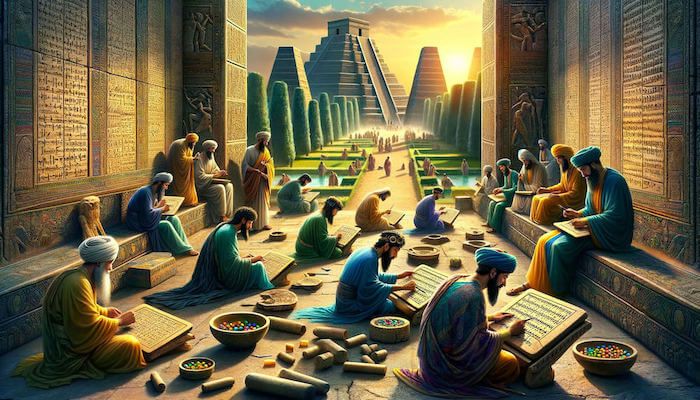10 Ancient Civilizations You Never Heard About in School
Introduction
The Hidden Side of History
10 Untold Stories from Ancient Civilizations You Never Learned in School. When ancient history comes to mind, many of us imagine Egypt’s pyramids, the Roman Colosseum, or the ancient Greeks’ philosophers. But there’s a different side to human history—teeming with amazing civilizations, puzzling feats, and mind-bending mysteries that never find their way into textbooks.
Why These Stories Are Relevant Today
These lost stories provide us with fresh perspective on human resourcefulness and resilience. They remind us that the ancients weren’t primitives—they were problem solvers, astronomers, artists, and engineers. Buckle up for your mind being blown. Let’s explore ten ancient tales that are more than due for the limelight.
- The Sumerian Star Maps
World’s First Astronomers
The Sumerians, living more than 5,000 years ago in modern-day Iraq, didn’t only create writing— they also were looking up at the sky. Archaeologists have found tablets of cuneiform that contain careful notes of observations of celestial objects.
Did They Know About Outer Planets?
One of the most hotly contested artifacts is the Planisphere, a star chart which some are convinced indicates awareness of Uranus and Neptune—planets that were allegedly beyond the naked eye. By telescope, by myth, the Sumerians obviously had a profound cosmic interest.
- The Urban Planning Wonders of the Indus Valley
Underground Drainage Systems
Way ahead of modern plumbing, Indus Valley cities such as Mohenjo-daro had public baths, covered drains, and grid roads. To live in a 4,000-year-old city with better hygiene than some contemporary cities would be unthinkable!
A City Without Kings?
In contrast to the other ancient civilizations, no palaces or temples have been discovered in these cities. That implies a society more controlled by community or commerce rather than by rulers or religion. That’s revolutionary stuff for the Bronze Age!
- The Egyptian Mystery of Brain Surgery
Trepanation in Ancient Egypt
We are all familiar with mummies, but did you know that some of them bear the scars of brain surgery? Trepanation—the technique of drilling holes in skulls—was performed in ancient Egypt, perhaps to repair brain damage or madness.
Evidence of Advanced Medical Knowledge
Some skulls even exhibit evidence of healing, i.e., the patients lived through the operation. That’s not only eerie—it’s a testament to the medical skills of Egypt thousands of years before the advent of anesthesia.
- Göbekli Tepe – The First Temple in the Kaaba
6,000 Years More Ancient than Stonehenge
Found in Turkey, Göbekli Tepe is a massive stone temple complex constructed around 9600 BCE. That’s more ancient than the pyramids and even more ancient than farming itself.
Hunter-Gatherers Constructed This?
The people who built Göbekli Tepe were not farmers—they were hunter-gatherers. This discovery turns our understanding of the timeline of human civilization on its head.
- The Nazca Lines of Peru
Geoglyphs Only Visible from the Sky
Giant figures carved into the Peruvian desert—hummingbirds, monkeys, and even astronauts. But that’s not all: the humongous drawings can be appreciated only from overhead. How did they achieve such precise proportions without air support?
Were They Messages to the Gods?
Some scientists believe that the lines were ritual roads or astronomical calendars. Others believe that they were gifts to sky gods. Either way, their original meaning is not yet discovered.
- Chinese Oracle Bones and Early Writing
Ancient Fortune-Telling Techniques
Long before horoscopes, ancient Chinese diviners used turtle shells and animal bones to predict the future. They’d heat the bones until they cracked and read the patterns like a cosmic barcode.
The Roots of Chinese Script
These bones, dating back to 1200 BCE, contain the earliest known Chinese characters—direct ancestors of modern Mandarin writing. Talk about old-school texting!
- The African Kingdom of Kush
Nubian Pharaohs
Too often in the shadow of their Egyptian counterparts, the Nubian Kushites were the rulers of Egypt as the 25th Dynasty. Black African kings did indeed sit on the throne of the pharaoh and construct their own pyramids.
The Black Forgotten Dynasty of Egypt
This epoch of Egyptian history isn’t frequently taught in the Western world, but it is important. The Kingdom of Kush wasn’t a copycat—because it was an empire of its own with a language, culture, and customs to itself.
- The Minoans and the Bull-Leaping Ritual
Europe’s First Advanced Civilization
The Minoans lived on the island of Crete in about 2000 BCE. Their palaces featured plumbing, multi-story houses, and breathtaking frescoes.
Myth, Sport, or Religious Rite?
One of the most famous murals depicts people jumping over bulls. Was it sport? A religious ritual? The origin of the Minotaur myth? We don’t know, but it certainly wasn’t your typical rodeo.
- The Olmec Colossal Heads
Predecessor to Mayan and Aztec Civilizations
Prior to the Maya and Aztecs, the Olmecs dominated portions of Mexico. They bequeathed upon us giant stone faces—some more than 9 feet tall and weighing 20 tons.
Who Did These Faces Portray?
Some believe the heads are portraits of rulers or warriors. Others propose athletes. Their broad faces and helmets indicate a culture that honored power and strength.
- The Japanese Jōmon Civilization
- Pottery Older than Egypt’s Pyramids
The Jōmon folk were making pottery already at 14,000 BCE—some of the earliest artists in the world. Their pots were not only useful—they were intricate and lovely.
Hunter-Gatherers with an Eye for Beauty
While most ancient pottery is practical, Jōmon ceramics are elaborate. This indicates that even ancient people cared about beauty and self-expression.
Conclusion
Rewriting What We Know
History is more than kings and conquests. It’s about innovation, mystery, and the collective brilliance of man. These untold stories challenge our myths and open us up to a richer, more inclusive history of what came before.
Why We Need to Dig Deeper into History
When we ignore these civilizations, we are denying ourselves the entire scope of human ability. Let’s bring them to center stage and give ancient genius the recognition it well deserves.
FAQs
- Why aren’t these stories taught in school?
Most curricula concentrate on Western civilization and use shortened timelines. These stories tend not to follow the standard model. - Are these civilizations related in some manner?
Although they developed separately, there may have been some influencing each other by way of early trade routes and patterns of migration. - What is the earliest civilization discussed in this article?
The Jōmon civilization in Japan, dating to approximately 14,000 BCE, is the earliest according to archaeological evidence. - Might these ancient people have possessed lost technologies?
Maybe. Some such achievements, such as the Nazca Lines or Sumerian star charts, are hard to account for with known ancient technology. - Where can I find out more about these stories?
Look for archaeology books, shows like Ancient Civilizations, or attend museum displays about lesser-known civilizations


